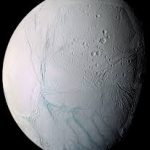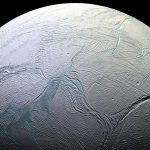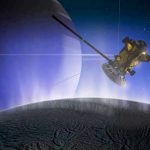Saturn’s ocean moon Enceladus has fresh ice in unexpected place0
- From Around the Web, Space
- September 22, 2020
Enceladus may be even more interesting than we thought.

Enceladus may be even more interesting than we thought.

Saturn’s tiny, frozen moon Enceladus is a strange place. Just 300 miles across, the moon is thought to have an outer shell of ice covering a global ocean 20 miles deep, encasing a rocky core. Slashed across Enceladus’ south pole are four straight, parallel fissures or “tiger stripes” from which water erupts. These fissures aren’t quite like anything else in the Solar System.

NASA’s Cassini spacecraft’s high-inclination Grand Finale orbits offered an unprecedented new view of Saturn and its environment. New research from the Grand Finale phase shows a powerful and dynamic interaction of plasma waves moving from the gas giant to its rings and its sixth-largest moon, Enceladus.

Using mass spectrometry data from NASA’s Cassini spacecraft, scientists found that large, carbon-rich organic molecules are ejected from cracks in the icy surface of Saturn’s moon Enceladus.

Searching for aliens is a tricky business. Most likely, the first alien life we discover will be hidden beneath miles of ocean on a distant world like Jupiter’s moon Europa or Saturn’s moon Enceladus.

Enceladus, an icy moon of Saturn that could host life, may have tipped over long ago.

Enceladus is ripe for life. In one final pass through the icy moon’s liquid plumes, NASA’s Cassini spacecraft found molecular hydrogen, which indicates favourable conditions for life in Enceladus’s subsurface sea.

Over the past decade, the international Cassini mission has revealed intense activity at the southern pole of Saturn’s icy moon, Enceladus, with warm fractures venting water-rich jets that hint at an underground sea. A new study, based on microwave observations of this region, shows that the moon is warmer than expected just a few metres below its icy surface. This suggests that heat is produced over a broad area in this polar region and transported under the crust, and that Enceladus’ reservoir of liquid water might be lurking only a few kilometres beneath.

Delicate space nets. Probes landing with the force of a bomb. Ice-burrowing tunnellers. These are a few of the robots poised to grab the baton from NASA’s Cassini orbiter in the search for alien life on Saturn’s icy moon Enceladus.

The gravitational pull of Saturn changes the amount of particles spraying from the south pole of Saturn’s active moon Enceladus at different points in its orbit.